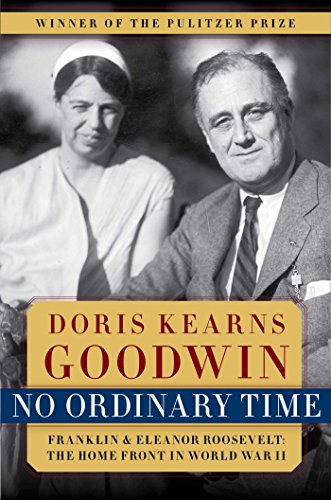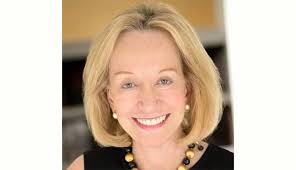No Ordinary Time: Franklin & Eleanor Roosevelt: The Home Front in World War II

from amazon.com
No Ordinary Time is a monumental work, a brilliantly conceived chronicle of one of the most vibrant and revolutionary periods in the history of the United States. With an extraordinary collection of details, Goodwin masterfully weaves together a striking number of story lines—Eleanor and Franklin's marriage and remarkable partnership, Eleanor's life as First Lady, and FDR's White House and its impact on America as well as on a world at war. Goodwin effectively melds these details and stories into an unforgettable and intimate portrait of Eleanor and Franklin Roosevelt and of the time during which a new, modern America was born.
https://www.amazon.com/No-Ordinary-Time-Franklin-Roosevelt-ebook/dp/B002HJV79U
Author: Doris Kearns Goodwin

Doris Kearns Goodwin is a world-renowned presidential historian, public speaker and Pulitzer Prize-winning author.
Ms. Goodwin graduated magna cum laude and Phi Beta Kappa from Colby College, and was a Woodrow Wilson Fellow. She earned a Ph.D. in Government from Harvard University, where she taught Government, including a course on the American Presidency, and, at the age of just 24, became a White House Fellow, working directly with President Lyndon Johnson. Ms. Goodwin served as an assistant to President Johnson in his last year in the White House, and later assisted him in the preparation of his memoirs.
Among her many honors and awards, Ms. Goodwin is the winner of the Charles Frankel Prize, given by the National Endowment for the Humanities, the Sarah Josepha Hale Medal, the New England Book Award, the Carl Sandburg Literary Award and the Ohioana Book Award.
Reviewed by: John Stokdijk

As implied by the title of No Ordinary Time: Franklin & Eleanor Roosevelt: The Home Front in World War II by
Doris Kearns Goodwin, WWll was an extraordinary time. History could easily have been very different and there are many reasons why Hitler lost the war. This book describes in detail the contribution of the United States towards the defeat of Nazi Germany.
During those dark years, the US, fortunately, was led by an extraordinary President, Franklin Delano Roosevelt. For many years I have had the opinion that FDR was the last great President of the most powerful country in the world. Nothing in this book gave me reason to change my mind.
FDR led an isolationist leaning country that was unprepared for war, a country that had not yet recovered from the Great Depression. The details of the conversion of the US economy to the production of military equipment essential for victory are fascinating. The numbers are incredible and exceeded what many thought were unrealistically high expectations.
...the final figures of the production estimates (45,000 aircraft in 1942, 100,000 in 1943; 45,000 tanks in 1942, 75,000 in 1943).
Perhaps because I am Canadian, I had the impression that Winston Churchill was the great man behind the Allied victory. But in this version of the history, FDR made several important and courageous strategic decisions which Churchill initially resisted. For example, I was surprised to learn of Churchill’s reluctance to invade France in 1944. However, Churchill was more skeptical than FDR of working with Joseph Stalin and subsequent history vindicated his judgment. With the benefit of hindsight, it now seems strange to read about FDR and Stalin agreeing on any issue while Churchill was the odd man out.
Both Roosevelt and Churchill were great communicators and rallied their people. But the fireside chats of FDR, very effective at that time, now seem quaint to me. The 1940s were not only not ordinary, they were also a very different time that I cannot relate to from personal experience.
No Ordinary Time captures the complexity of the time and the complexity of the man, Roosevelt, and tells a very personal story. Sometimes books are inappropriately simplistic but Goodwin does not make that mistake. The result is a lengthy book but I never felt that any of the contents were unnecessary and the material was always easy to read.
The women in the life of FDR, and his relationships with them, were an essential aspect of his life and a colorful part of the story.
Sara Delano Roosevelt
“I think Franklin will forget all the irritations & remember only pleasant things,” Eleanor wrote… Unable to accept that her son was a grown man even when he was president of the United States, Sara would pester him constantly to wear his rubbers and listen in on his phone calls.
Eleanor Roosevelt
Eleanor Roosevelt was more than “an unusual person”; she was unique. She had seized the power inherent in the position of first lady, to become, in the words of a contemporary reporter, “a Cabinet Minister without portfolio,” an influential advocate for social reform.
Anna Roosevelt
“Father could relax more easily with Anna than with Mother,” Elliott observed.
Lucy Mercer
The extended White House family also permitted Franklin and Eleanor to heal, or at least conceal, the incompletions of their marriage, which had been irrevocably altered by Eleanor’s discovery of Franklin’s affair with Lucy Mercer in 1918.
Marguerite “Missy” LeHand
Missy went on to become the most celebrated private secretary in the country… Missy’s genius was not simply in doing everything she was asked to do with exceptional skill, but in anticipating the wants and needs of her boss before he knew them himself.
The woman in the life of Eleanor Roosevelt and her relationships with her remains an unsolved mystery, although some today believe there is no doubt.
For her part, Hick (Lorena Hickok) counted the days until she and Eleanor could be together again. Having found the love she had been seeking all her life, she was miserable without Eleanor.
...the essential question for the biographer is not whether Hick and Eleanor went beyond kisses and hugs, a question there is absolutely no way we can answer with certainty. The far more absorbing question, and the one that can be answered, is what role the precious friendship played in each of their lives at that particular juncture.
While FDR was the pragmatic politician, Eleanor Roosevelt was the idealistic social activist. I have long been aware that she was greatly admired by many, but now I understand why. She stands beside FDR in history as the last great First Lady.
The open support for segregation in the 1940s and the widespread belief that Negroes were inferior were appalling to read about. The work of Eleanor Roosevelt on their behalf was inspiring and set the stage for the civil rights movement of the 1960s. Yet now, decades later, I am saddened by the current state of affairs and the amount of work yet to be done for minorities.
The same can be said about ER’s advocacy on behalf of women.
The nation could not afford, Eleanor warned, to return to an economy of scarcity in which women and minorities were denied the right to work.
This book does not present only the successes of FDR. He made some mistakes, big mistakes. The internment of the Japanese-Americans remains a black mark on his presidency. The failure to help the European Jews while there was still time to do so was tragic. The failure to oppose Stalin in Poland had grave consequences.
Because of his death on April 12, 1945, FDR did not attend The United Nations Conference on International Organization in San Francisco, perhaps his most visionary idea.
“Peace, like war,” he said, “can succeed only where there is a will to enforce it, and where there is available power to enforce it. The Council of the United Nations [the name Roosevelt had conceived the first time Churchill visited him in Washington had stuck] must have the power to act quickly and decisively to keep the peace by force, if necessary.
But it takes much more than a great man with a great vision leading a great country to a great victory to bring about world peace. The inability of the United Nations to achieve its primary purpose is a great disappointment. Regrettably, today it seems the world lacks great men with great visions to meet great needs leaving us without the high hopes apparent after WWII.
I would like to end my book report on a positive note but I cannot do so. The book ends with an Afterword which I found rather depressing. Once again we are reminded that “happily ever after” is for works of fiction.
Harry Hopkins (one of FDR’s closest advisors) resigned from the government after Roosevelt died… Four months later, in January 1946, Hopkins died. He was fifty-five… Malvina Thompson (who worked for ER) died in a New York hospital from a brain hemorrhage. She was sixty-one… Crown Princess Martha (a close friend of FDR) died of a liver ailment at the age of fifty-three… Lucy Mercer Rutherfurd… died in July 1948, at the age of fifty-seven… Anna (Roosevelt) and John Boettiger... divorced (in 1949). The following year, John committed suicide… Anna died of cancer in 1975, at the age of sixty-nine… FDR, Jr., died of cancer in 1988, on his seventy-fourth birthday… He was married five times.
In October 2017, ABC co-hosted a public event presenting Nomi Prins, author of All the Presidents’ Bankers - The Hidden Alliances that Drive American Power. My review of her book is posted on this website. I have now added to it a few interesting paragraphs written by Prins about the relationship between FDR and bankers.
